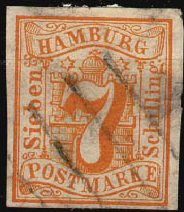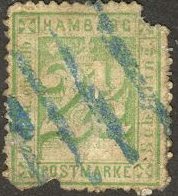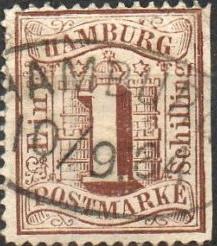 |
|||||
|
|||||
| Preview of Stamps Catalogue: VOLUME 1 |
 |
|||||
|
|||||
| Preview of Stamps Catalogue: VOLUME 1 |
Note: on my website many of the
pictures can not be seen! They are of course present in the catalogue;
contact me if you want to purchase it.


(Black and blue bars cancel, I don't know if they are genuine)
According to 'The Stamps of the German States', by B.W.H.Poole, the genuine cancel should consist of four parallel lines (either thick or thin), 20 mm long and about 5 mm apart. Forged cancels exist with too short bars, more than four bars etc.

(Genuine blue wavy lines cancel; "Wellenstempel von
Ritzebüttel", reduced size)
The Ritzebuttel cancel was often applied on the sheet and then the stamps were pasted on the letters when needed. Thus there is very often no trace of the cancel on the letters with this cancel.



(Butterfly cancel, left stamp reduced size)
Three ring cancel with number in the center (the 2 1/2 sch green of the 1864 issue can only be found with this Danish cancel!):
This cancel was originally used by the two Danish post offices in Hamburg (Dänisches Oberpostamt). During the war between Prussia and Denmark these post offices were occupied by the Prussians. The cancels (numeral cancel 2) were then used on stamps with destination Denmark or Schleswig-Holstein. There seem to be two types of this cancel: with slightly smaller and with slightly larger '2'. Experts are capable of distinghuishing in which of the two post offices the stamp was cancelled. Source: http://www.sporvejenes.dk/udst/UDSTILLING/SLESVIG_GB2.HTML


(Blue or black cancel "St P.A. HAMBURG")


An oval cancel with "HAMBURG" on top and the date
below.
Examples:
A circular cancel with 'HAMBURG' and two stars on each side was used to cancel remainders (to increase the value of the stamp). This cancel was only used as an arrival cancel on envelopes, but never to cancel stamps! So these stamps are genuine stamps with a fake cancel. In 'Philatelic forgers, their lives and works' by Varro E. Tyler, we can read that the forger Julius Goldner obtained these genuine cancels with various dates of 1866 and 1867 from a post office official in 1868. He then cancelled remainder Hamburg stamps that he had obtained earlier. However, the book 'Handbuch der Neudrucke' by Ohrt says on page 348 that these cancels themselves were also forged. According to Ohrt, the stars in the above forged cancels are much larger.
In the Philatelic Journal of America March 1893,
No 111, page 122, in an article translated from Hugo Krotzsch, it
is said that:
"Cancellation Counterfeits.- We wish again to caution
our readers against the Hamburg cancellation in a simple circle
and between 2 6-rays stars; to all appearance this is a
counterfeit. The best known counterfeit however, is the
"St.P.E.Hamburg'' in a blue double circle, which is found on
the 1/2, 2, 3, 4 and 2 1/2 Schilling; it is usually visible in 3
or 4 parts.Many genuine postage stamps are provided with
counterfeit cancellations, most of them having been manufactured
by E. R. Krippner of Freiburg
in Saxony. The district attorney of Freiburg has advised us that
these these counterfeit cancellations are to be found on all
values of the first and second\par issue".
In the book Emil Reinhard Krippner und seine Falsifikate
from Hans Friebe the following four forged cancels of Krippner
are listed (images can also be found there):
1) the Ritzebuttel wavy cancel
2) four bar cancel
3) two ring cancel 'St.P.E.Hamburg 27.VI'
4) two ring cancel 'Hamburg St.P. 31 10 67 2-3N'